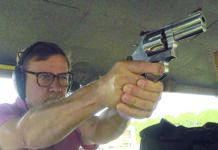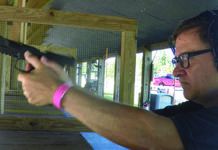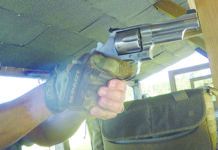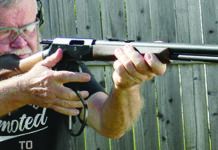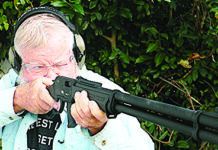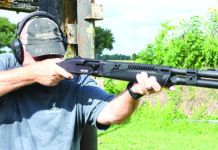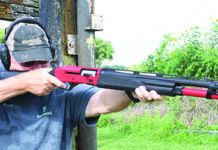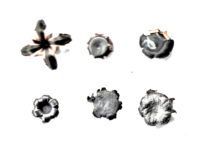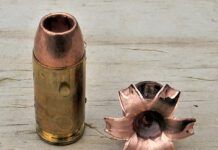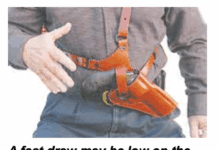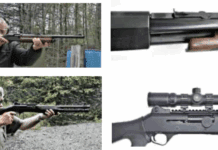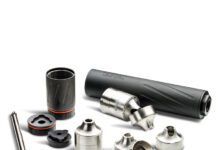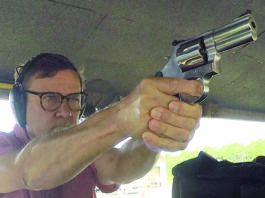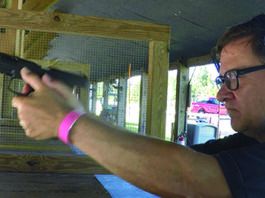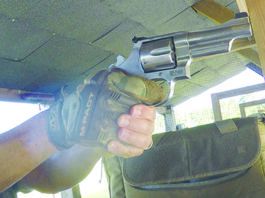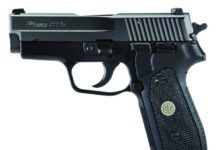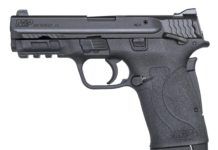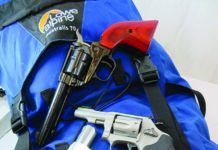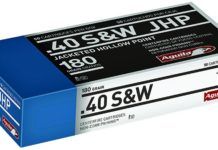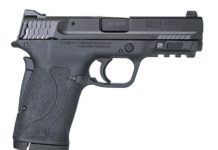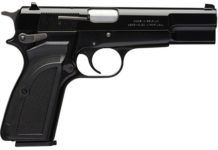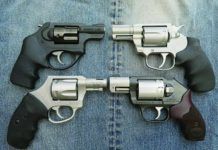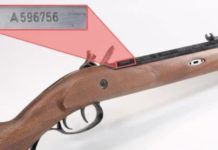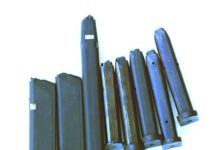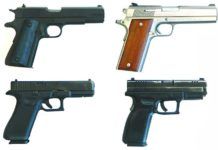Personal-Defense 9mm Handgun Shoot Out: Smiths M2.0 Wins
The most popular concealed-carry and home-defense handgun in America is likely the 9mm self loader. There are service grade and service-size pistols, compacts, and subcompacts available in this chambering, which has gained popularity because of improved bullet function. In this installment, we are firing purpose-designed compact handguns that are derived from service-size handguns. When the Glock 19X was introduced, with its Glock 17 grip and Glock 19 slide, our shooters knew it would be a hot new gun to test, but we did not quite know what to match against it. The editor dubbed it a Commander-size Glock 9mm, so we found a 9mm 1911 Commander to brace against it — the Ruger SR1911 Commander. The SR1911 Commander is, after all, a full-size Government Model pistol with the slide shortened three-quarters of an inch. The Glock 19X is a Glock 17 with a short slide and full-size grip. Bingo.
European compacts generally have both the slide and the butt shortened. One example is the SIG P225A, a short version of the SIG P220 9mm handgun. Today, SIG offers an updated and revamped P225-A1. We added this double-action-first-shot pistol as a counterpoint to the double-action-only and single-action pistols tested. Next, we added a true compact with both a short slide and short frame, the Smith & Wesson M&P9 Compact M2.0. It seemed fitting to match the M2.0 M&P9 against the Glock 19X Gen5 gun.
No Go Bang Sometimes: M&P 380 SHIELD EZ Manual Thumb Safety
"It seems the function of the M&P 380 Shield EZ Manual Thumb Safety pistol can be influenced by the type and quality of ammunition used with the pistol," said Todd Woodard, Editor of Gun Tests Magazine. "Most gun owners realize that's the case with most firearms.
New Kit-Gun Revolvers from Charter Arms, S&W, Heritage
A Kit Gun, by definition, is a small-frame revolver that is packed up with rest of the kit when fishing, hiking, camping, hunting, or some other outdoor pursuit are being planned. The intention of the Kit Gun is to deal with pesky varmints raiding your cooler or a coiled viper in the middle of a foot trail that refuses to move. They also help decide bragging rights around the campfire after a session of plinking empty soda cans. These revolvers have been called Kit Guns since after WWI, but S&W was the first to use the name in 1935 on the 22/32 Kit Gun, which was built on the now-discontinued I-frame. This original Kit Gun had an adjustable rear sight, a DA/SA trigger, short barrel, and a smallish grip. Since then, the features of a Kit Gun have come to include single-action triggers, fixed sights, and snubnose-length barrels. It could be argued the semi-automatic 22 rimfire pistols have usurped the revolver's position, but that is for another test.
We took a look at three of the latest packable handguns, which included a S&W Model 317-3 Kit Gun, Charter Arms Pathfinder Lite, and Heritage Manufacturing's Small Bore single action. We were looking for a lightweight revolver that was accurate enough to shoot the head of a snake at 10 yards, had the ability to accurately fire a variety of 22 rimfire ammo, and be safe should we accidentally drop the revolver while trekking through the great outdoors.
We tested at 10 yards, which we thought was an optimum distance for these rimfires and used a variety of 22 rimfire ammo, including 22 LR with a range of bullet weights and types, 22 Short, and 22 Shot cartridges. Ammo consisted of commonly found CCI Mini Mag with a 36-grain copper-plated hollowpoint (CPHP), CCI Target 22 Short with a 29-grain lead roundnose (LRN) bullet, Browning BPR 37-grain fragmenting hollowpoints, and the hot Aguila Supermaximum loaded with a 30-grain CPHP. We also tested Federal Game-Shok Shot cartridges loaded with #12 shot. We used a rest and fired the revolvers in single-action mode to gauge accuracy. Then we let loose, plinking away in both DA and SA mode, using a two-hand hold until all the ammo was gone. Here's what we found out.
New Handguns and Ammo for 2018
Gun Tests reporters and editors on the scene at SHOT Show 2018 in Las Vegas scoured the show for new pistol and handgun accessory entries for our readers to consider this year. Amazingly, a handgun made of steel with a design more than 100 years old — the fabled 1911 — still drives the market. A third of the new guns that follow are based on this legendary platform, followed closely by pocket pistols, and it's clear the revolver is not the antiquated firearm many assume. In fact, when it comes to handguns, 2018 is a good mix of old, new, plastic, and steel, with a wheelgun or two thrown in for good measure, along with loads for defensive handgun use to feed these new beasts. Here's a rundown on a few new handgun and ammunition choices for 2018 that our staff thought were notable and which we'll be looking to include in future issues.
S&W’s New M&P380 Shield EZ Pistol Is Supposedly Easy to Use
Smith & Wesson's new M&P380 Shield EZ pistol is a personal-protection and everyday-carry sidearm which is being marketed as easy to use (EZ), a test consideration that Gun Tests Magazine's concealed-carry readers ask about all the time.
Browning Ends Production of Hi-Power Pistol Line for Second Time
Browning has announced that its Hi-Power pistol production has ended, effective EOY 2017. That's a shame, according to Gun Tests Magazine, which has tested various Hi-Powers over the years and found them to be generally effective as concealed-carry weapons (CCW).
New Revolvers from Kimber, Charter Arms, Ruger, and Colt
Why are there so many snubnose revolvers being manufactured? There is no sign that big-bore snubnose revolvers are going away any time soon, especially with manufacturers introducing new snubnoses. Snubnose wheelguns have been and are still excellent choices for self-defense sidearms. Easy to use, no magazine to lose, and chambered in powerful calibers, revolvers are here to stay. So we took a look at four new snubnose revolvers: the Charter Arms Boomer, Ruger's LCRx, the Kimber K6s CDP, and the Colt Cobra. These snubnose revolvers all proved to be reliable, safe, consistent, and accurate for self defense. What we experienced with these revolvers was a variety of grip sizes, some of which our testers said were too small for comfortable shooting or they were too big for ideal concealed carry.
The sights on three guns were very serviceable, while one didn't have sights at all. The triggers separated the pack, as did the chamberings. Two used a double-action-to-single-action trigger and two featured a double-action-only (DAO) trigger. A revolver chambered in 357 Magnum offers convenience because it can shoot 38 Special ammo, too. After tallying the scores, in our opinion the Ruger LCRx is a good choice for concealed carry, though we would tweak it. The Charter Arms Boomer, Kimber K6s, and Colt Cobra are all pretty good choices, but as you will see, the devil is in the details on those three.
We tested at 10 yards because these snubnose revolvers are made for concealed carry and short-range encounters. But we learned 10 yards was too far if you don't have sights, so we accuracy tested the Charter Arms Boomer at 7 yards. Not having sights is a liability as the distance between you and a bad actor increases. Though we typically test at 25 yards, FBI data shows that most gunfights between an officer and an attacker occur from a distance of 0 to 5 feet apart. We concealed-carry citizens can expect the same. The reality is these revolvers are made for up-close work. Short sight radii, smallish grips, and DA triggers do not make for tack-driving accuracy.
We also carried these revolvers in inside-the-waistband (IWB) and appendix-carry-style holsters. We took the time to practice our draw and dry-fire these revolvers at an imagined bad actor a few steps away. On the range, we tested for accuracy using a rest. The DA/SA trigger mode on the LCRx and Colt provided an edge over the DAO models. We also tested a variety of ammunition, and the K6s and LCRx proved to be more practical and versatile because they can fire both 38 Special and 357 Magnum cartridges. Here's what we thought about each handgun in more detail.
New Cimarron Firearms: SHOT Show 2018
Here's a behind-the-scenes look (literally) at Cimarron's new-product offerings for 2018.
Tips on How to Dress for Concealment
Gun Tests reviews tactical and concealed-carry-weapons (CCW) clothing from time to time, but there are also some general aspects of CCW clothing to consider, which Armscor has recently promoted on its blog. We pass along these tips for your consideration, along with links to stories Gun Tests has covered in terms of clothing, firearms, holsters, and other equipment suitable for CCW wear.
Lyman Recalls Black-Powder Rifles and Pistols
Gun Tests has learned that Lyman Products Corp. ("Lyman") is voluntarily recalling black powder rifles and pistols due to the potential of separation in the breech plug.
Non-1911 Magazines: We Test A Passel of Them Head to Head
You can never have enough magazines. Modern pistol shooters practice hard; compete in IDPA, IPSC, and Three Gun matches. They need reliable equipment. Personal-defense shooters need reliable, functional magazines at a fair price. In this installment, we are testing magazines for fit, function, reliability and durability. In common with recoil, striker, and hammer springs, magazines should be replaced from time to time. While new springs may help magazines retain some function, there is a time when cracked or bent feed lips demand the magazine be discarded.
In this test, we followed the same criteria we used in testing 1911 magazines, except this test was more diverse in both handguns and cartridges. The handguns used in the test were proven examples, with few function exceptions. Since the firearms had long-ago proven reliable, there would be no confusion as to which part was responsible for the malfunction, the pistol or the magazine. We also used good-quality ammunition to test the magazines. In each case, we used at least two magazines of each type to bang on.
Using proven criteria and a team of experienced raters, we learned some magazines were durable and service grade; that is, we would be comfortable putting them into "service" in critical situations. We also learned others were okay for range use, but not critical use. In all of these cases, we recommend spending a little more for service-grade magazines across the board for all uses. We don't think it's advisable to mix low performers with high performers in this critical area of function.
Hot Handguns and Cartridges From Springfield, Coonan, Glock
For more than a year, we have been testing and evaluating some of the most powerful and interesting self-loading handgun cartridges. These are the ubiquitous 9mm Luger, which we think has become the baseline against which all other handgun chamberings can be compared, and the far-less-common but still commercially viable 38 Super, 357 SIG, and 357 Magnum, the last of which is chambered in a Coonan handgun. The evaluation was the result of a reader request, and three of which, the 9mm, 38 Super, and 357 SIG, sometimes use the same bullets, but at different velocities.
We began with a number of goals. First, as always, reliability has to be foremost because the handguns were competing as personal-defense choices. We also viewed them as outdoors-carry choices for defense against feral dogs and big cats. We wanted to see how efficiently each cartridge delivered its power, with the idea that the 9mm set the floor. Increased flash, blast, and recoil may be counterproductive in the others, and as it turned out, we got more horsepower with less recoil than expected. The energy difference wasn't incremental; it was profound. We didn't choose average 9mm or 38 Super loads, but instead picked those loads that had given good results in the past. Only the top performers in 9mm and 38 Super are in this report. With the 357 SIG and 357 Magnum, we were on new ground and chose a representative sample of bullet weights. The 357 SIG and 357 Magnum enjoy an excellent reputation for terminal ballistics. The 9mm, less so, and based on previous data, we expected the 38 Super to be as effective or more than a 9mm Luger +P+ load. The primary consideration was personal defense, so control was important. The larger guns may not be ideal for concealed carry, but would be good handguns for field use or home defense. For those wishing to deploy a handgun with plenty of power and accuracy, the 357-caliber self-loaders are easier to control than Magnum revolvers. The self-loaders demonstrate less recoil due to the smaller charge of faster-burning powder and the movement of the action and compression of springs as the handgun is fired. So how would they compare to the revolver? As it turned out, these modern powerhouses outclass the 357 Magnum revolver, in our opinion, on many levels.
We collected a good supply of ammunition, five loads for each gun versus our usual three. We chose three powerful hollowpoint loads for accuracy testing, as is SOP for Gun Tests. We added a fourth load for ballistic testing to test penetration and expansion. We added an economical practice load for use in the combat-firing test phase. So, this was a thorough test requiring several months. We elected not to go lighter than 115-grain bullets in any chambering. The 357 SIG, 38 Super, and 9mm Luger are usually loaded with bullets in the range of 115 to 147 grains. We fired 125-, 140-, and 158-grain bullets in the 357 Magnum Coonan. Here are the results.



